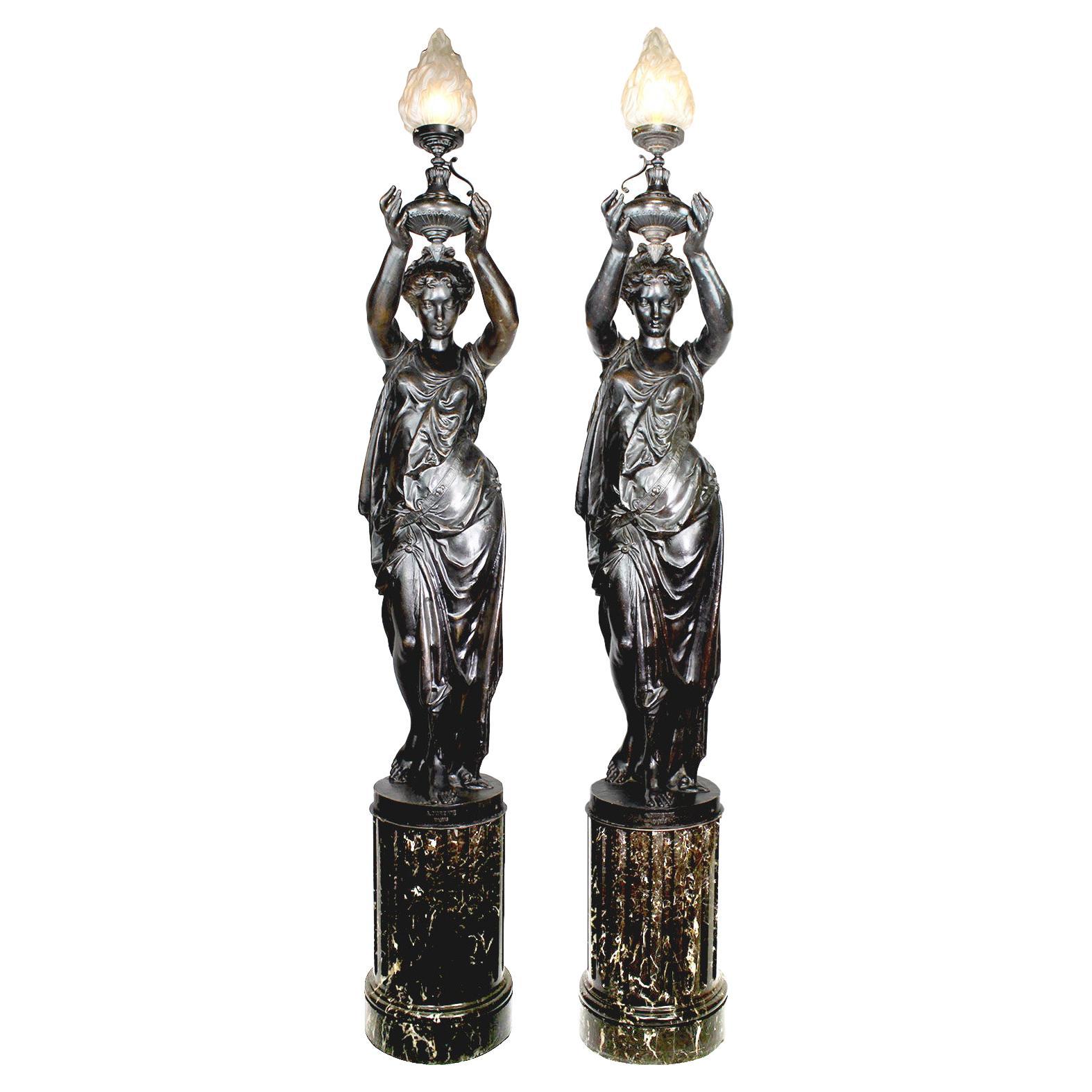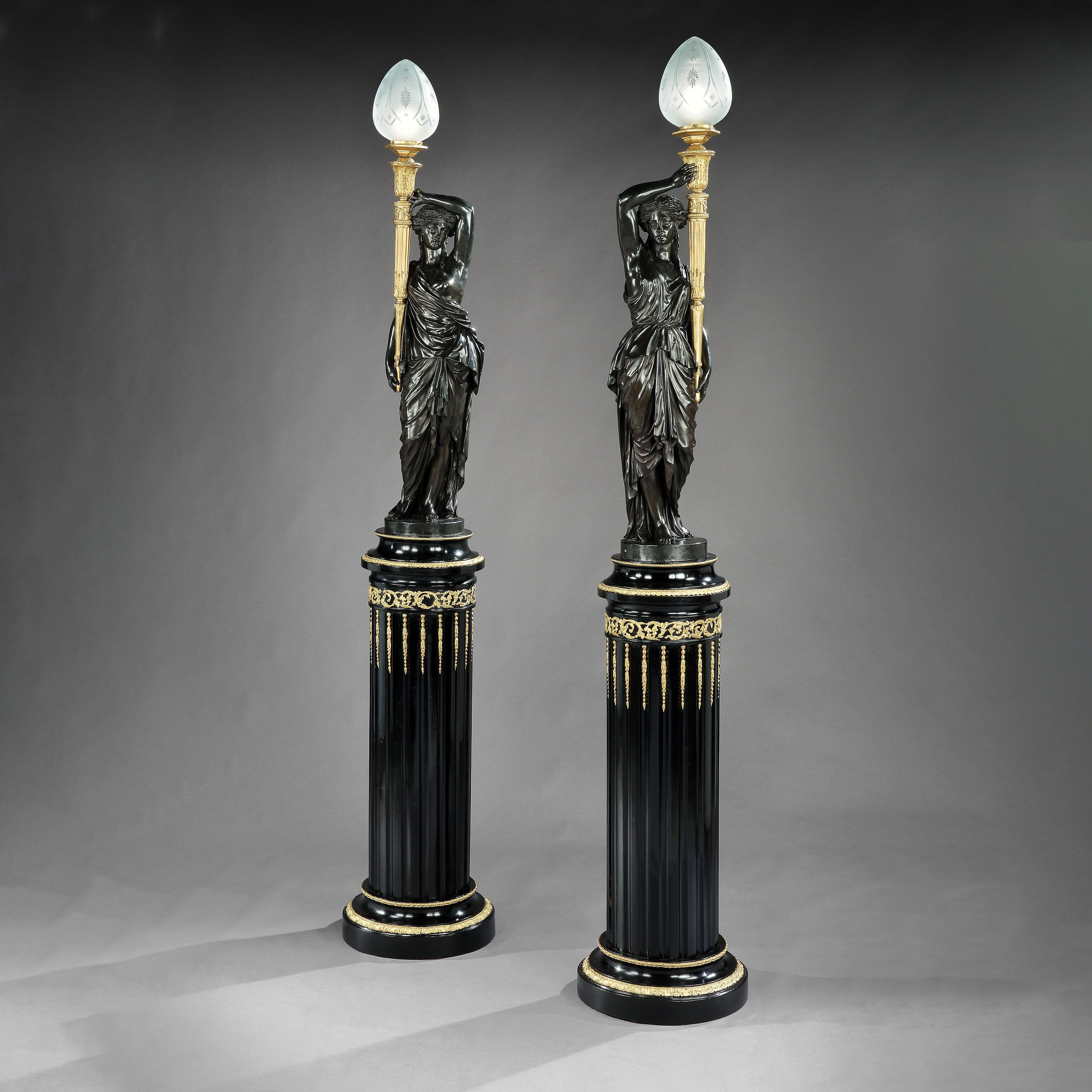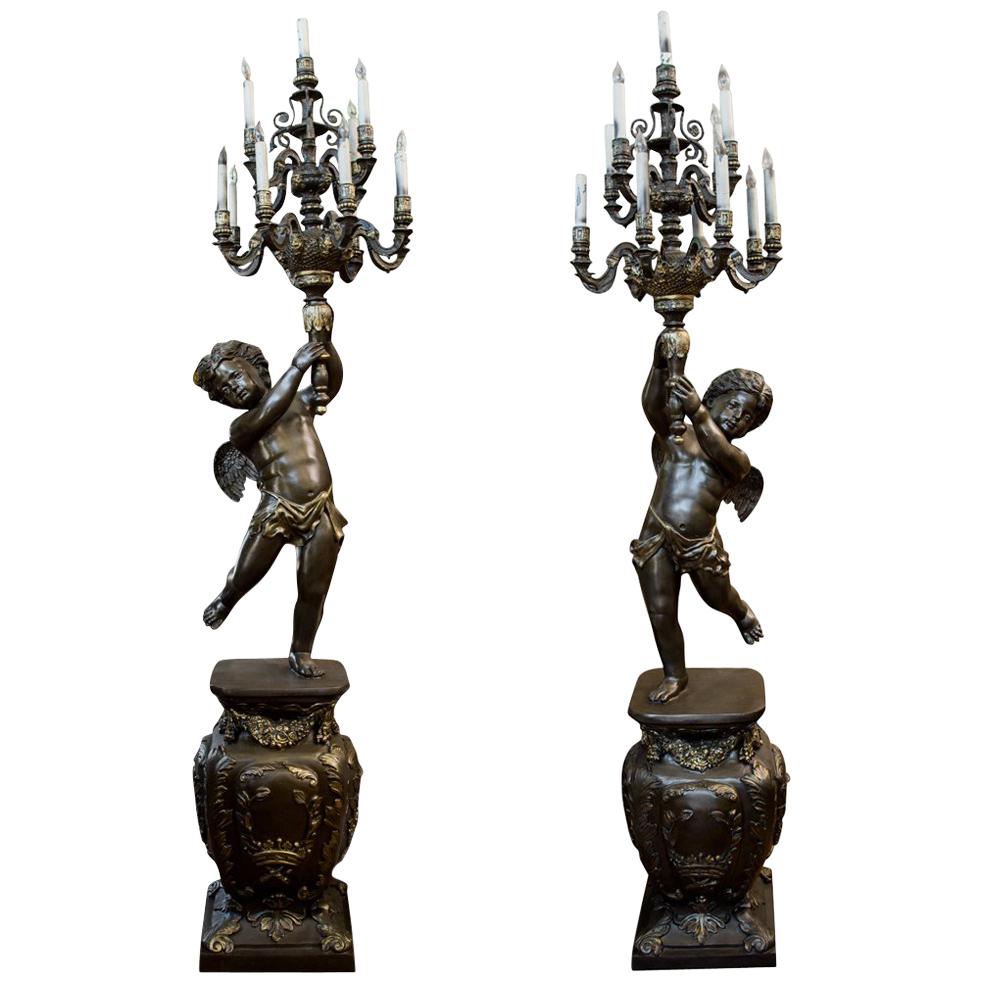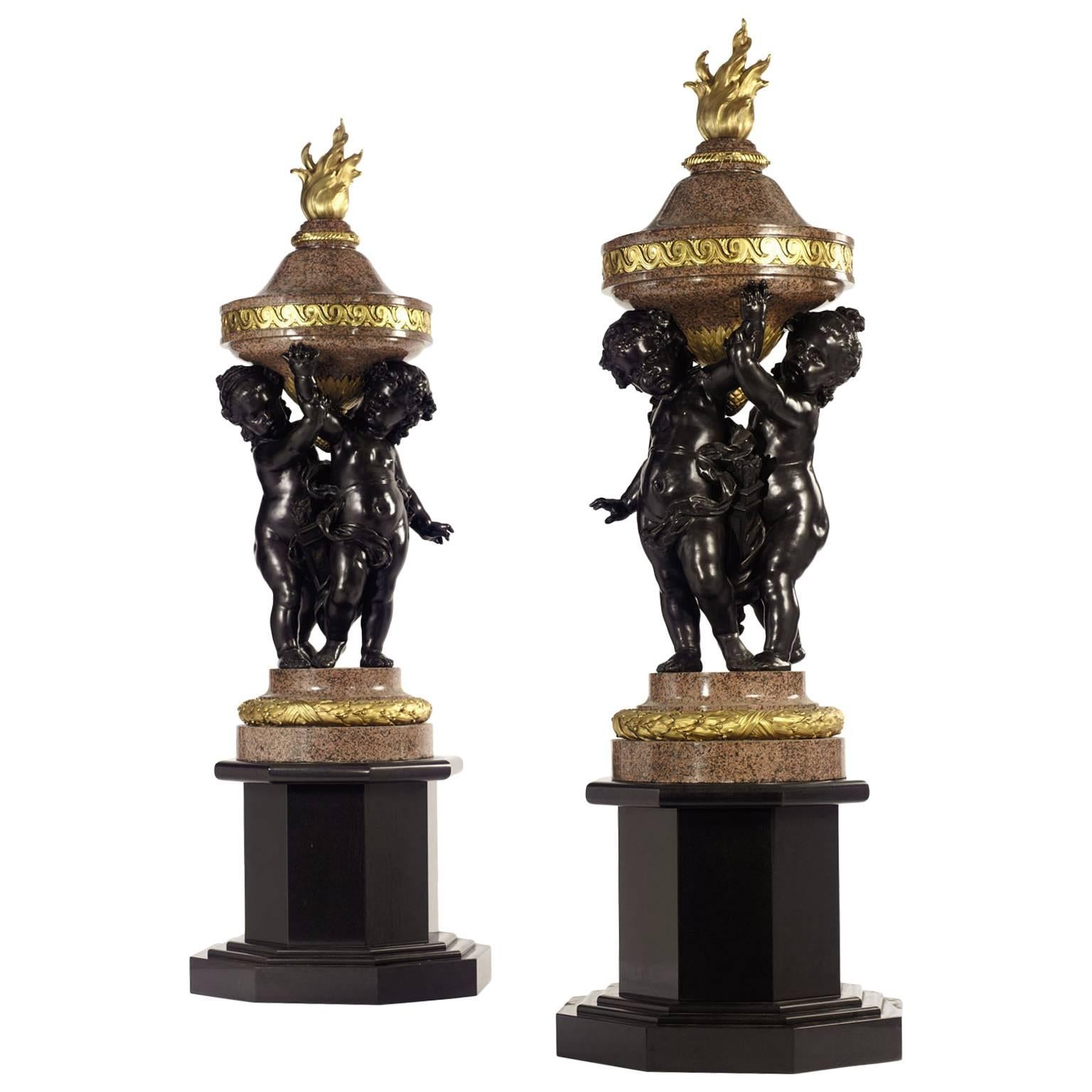Items Similar to French 19th Century Torchère
Want more images or videos?
Request additional images or videos from the seller
1 of 17
French 19th Century Torchère
About the Item
A very intriguing later 19th century French torchère - Standing candelabra - in expertly hand forged iron. A beautiful art piece.
- Dimensions:Height: 71.25 in (180.98 cm)Width: 44.5 in (113.03 cm)Depth: 15.25 in (38.74 cm)
- Materials and Techniques:Iron,Forged
- Place of Origin:
- Period:
- Date of Manufacture:circa 1880
- Condition:Wear consistent with age and use.
- Seller Location:Atlanta, GA
- Reference Number:
About the Seller
5.0
Vetted Seller
These experienced sellers undergo a comprehensive evaluation by our team of in-house experts.
Established in 2008
1stDibs seller since 2012
593 sales on 1stDibs
Typical response time: <1 hour
- ShippingRetrieving quote...Ships From: Atlanta, GA
- Return PolicyThis item cannot be returned.
More From This SellerView All
- Set of 6 Mid-19th Century Lacquered Pique Cierges, TorcheresLocated in Atlanta, GAA stunning set of 6 Pique Cireges from London, England. Beautifully constructed from lacquered wood with metal accents. Super chic. The Pique Cierges may be purchased in the set of 6...Category
Antique Mid-19th Century English Floor Lamps
MaterialsWood
- French 16th Century Torchere, Standing LanternLocated in Atlanta, GAAn outstanding late 16th century Torchere, standing lantern from the Avignon region of France. Expertly crafted from hand forged iron. Exceptional pat...Category
Antique 16th Century French Floor Lamps
MaterialsBerlin Iron
- Spanish 18th Century Iron TorchereLocated in Atlanta, GAA very handsome 18th century torchere in hand-forged iron - from the Catalan region of Spain. Excellent craftsmanship.Category
Antique Late 18th Century Spanish Floor Lamps
MaterialsIron
- Spanish 18th Century Iron TorchereLocated in Atlanta, GAA wonderful primitive 18th century torchere from the Catalan region of Spain. Soundly constructed from sturdy oak and iron.Category
Antique 18th Century Spanish Floor Lamps
MaterialsIron
- Delightful French 19th Century Toy HorseLocated in Atlanta, GAA delightful later 19th century toy horse constructed from painted metal. A charming accent piece for any living area.Category
Antique Late 19th Century French Toys and Dolls
MaterialsMetal
- Pair of Italian Early-20th Century TorcheresLocated in Atlanta, GAA very lovely early-20th century Italian Torcheres in beautifully crafted iron. Both measure 73 1/2" H..... Both candelabras measure 29 1/4" in diameter. One torchere measures 29 1/4...Category
Early 20th Century Italian Floor Lamps
MaterialsIron
You May Also Like
- Pair of French 19th-20th Century Neoclassical Style Cast Iron Figural TorchèresLocated in Los Angeles, CAA very fine pair of French 19th-20th century neoclassical style patinated cast iron figural torchères by A. Durenne, Paris, each representing a figure of a standing young maiden, her arms raised forward while holding a a flaming urn gas light (Now electrified) with a frosted glass flame, each raised on a veined grey marble column stand, both cast-signed 'A. Durenne, Paris'. Antoine Durenne was an internationally renowned French art founder. He attended École Nationale Supérieure des Beaux-Arts in 1842. Durenne purchased a small foundry in Sommevoire, near the Val d'Osne, Haute-Marne, France and established The Durenne firm, circa Paris, 1900. Cast-iron had been in production during the 18th century but its inferior status to the more fashionable and delicate wrought iron had generally confined its use to architectural work. By the early 19th century, however, rapid developments of the Industrial Revolution combined with the simultaneous burgeoning of a new middle class provided the impetus for a dramatic Expansion in its application and in a short space of time a proliferation of iron foundries across Europe and America thrived on the production of everything from inkstands to railway stations. The use of cast-iron for garden ornament became particularly widespread at this time, as the possibilities for its mass-production at a fraction of the cost of bronze made it the material of choice for outdoor statuary...Category
Antique Early 1900s French Neoclassical Revival Figurative Sculptures
MaterialsMarble, Iron
- Magnificent Pair of 19th Century Bronze Figural Torchères by Henry DassonBy Henry DassonLocated in London, GBConstructed from patinated and gilded bronze, the large figures clothed in the Antique style, after the original design by Jean-Joseph Foucou, today residing at the Louvre, posed in ...Category
Antique 19th Century French Neoclassical Revival Floor Lamps
MaterialsBronze
- Imposing 19th Century Bronze Torchere, by CoutanLocated in Brighton, SussexThis very fine patinated bronze figural torchere modeled as a classically clad female musician holding a mandolin and a marble torch. This symbolic representation of Music, falls within Coutan’s allegorical work. We have a number of marble pedestals this Torchere would stand on. Inscribed on base: Coutan, Thiébaut Frères, Fondeurs. Jules-Félix Coutan (22 September 1848 – 23 February 1939) is considered to be one of the most gifted French sculptors and designers of the 19th and early 20th centuries Coutan studied under the renowned Pierre-Jules Cavelier at the Ecole des Beaux-Arts in Paris, and was awarded the Prix de Rome in 1872; after his return to Paris he executed the fountain group France Bearing the Torch of Civilization for the Exposition Universelle (1889), one of the two prominent sculptural commissions for the Exposition grounds.[1] Later he taught at the École des Beaux-Arts from 1900, where he expressed his disdain for the researches of Rodin— fumiste—[2] and the Impressionist sculptors who followed him. Coutan was elected to the Académie des Beaux-Arts in 1905.[3] Coutan is best known in the United States for the sculptural group above the entrance to Grand Central Terminal in New York City. For Grand Central Terminal, Coutan was contracted to provide a quarter-size scale plaster model of the three-figure allegorical Transportation group, which he developed from 1911 through 1914. The carving was performed by the William Bradley & Son of Long Island City.[4] Among Coutan's students were Hippolyte Lefèbvre, Raymond...Category
Antique 19th Century French Neoclassical Figurative Sculptures
MaterialsBronze
- Pair of Monumental French Napoleon III Style Patinated Thirteen-Light TorchèresLocated in Los Angeles, CAA pair of large French Napoleon III style metal thirteen-light figural torchières.depicting two winged cherubs holding up a thirteen-light torchère, standing on bases with gold highl...Category
20th Century French Napoleon III Floor Lamps
MaterialsMetal
- Monumental Pair of French 19th-20th Century Putto Flambeaux Urns TorcheresBy René Rozet 1Located in Los Angeles, CAMonumental pair of French 19th century figural gilt and patinated bronze Rosso Granite marble Flambeaux Urns Torcheres, each depicting a pair of allegorical Putti (Children) holding ...Category
Antique 1890s French Louis XV Figurative Sculptures
MaterialsGranite, Bronze
- Palatial French 19th-20th Century Allegorical Figural Cast Iron Group TorchereBy Val D'Osne FoundryLocated in Los Angeles, CAA very fine and palatial French 19th-20th century allegorical figural cast-iron group torchere - sculpture - fountain - representing spring and the harvest, probably cast by Le Fonderies d'Art du Val d'Osne. The charming four-putti sculpture with a front standing putto holding a pole amongst wheat stalks, another putto kneeling and collecting wheat, a third one wearing a hat and picking flowers for a wreath and the fourth kneeling putto holding a bird's nest, all below an elongated classical stem with a glass globe (Electrified), circa: Paris, 1900. Overall height: 84 inches (213.4 cm). Width: 29 1/2 inches (74.9 cm). Circular base diameter: 24 inches (61 inches). Cast-iron had been in production during the 18th century but its inferior status to the more fashionable and delicate wrought-iron had generally confined its use to architectural work. By the early 19th century, however, rapid developments of the Industrial Revolution combined with the simultaneous burgeoning of a new middle class provided the impetus for a dramatic expansion in its application and in a short space of time a proliferation of iron foundries across Europe and America thrived on the production of everything from inkstands to railway stations. The use of cast-iron for garden ornament became particularly widespread at this time, as the possibilities for its mass-production at a fraction of the cost of bronze made it the material of choice for outdoor statuary...Category
Antique Early 1900s French Rococo Figurative Sculptures
MaterialsIron
Recently Viewed
View AllMore Ways To Browse
Lighting Torcheres
Torchere Lamp
Torcheres Floor
Torchere Floor Lamp
French Torchere
Standing Lamp 19th
Antique Floor Lamp Black
19th Century French Floor Lamp
Iron Standing Lamp
Floor Standing Lamp Antique Furniture
Antique Floor Standing Lamps
Antique Floor Standing Lamp
Antique Floor Standing Lamp Lamps
Antique Standing Floor Lamp
Forged Lamps
Black Torcheres
Iron Torchere
Iron Torcheres





